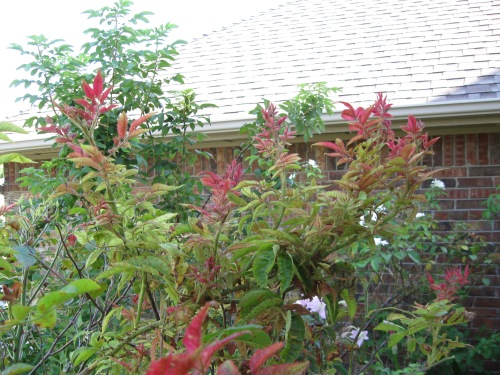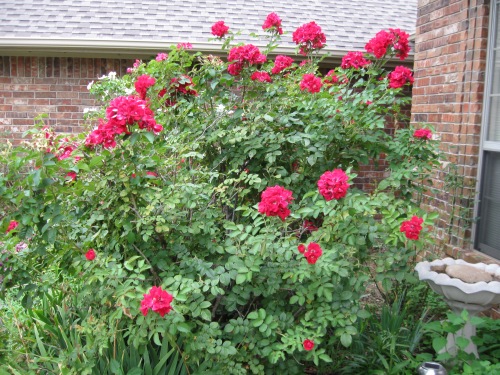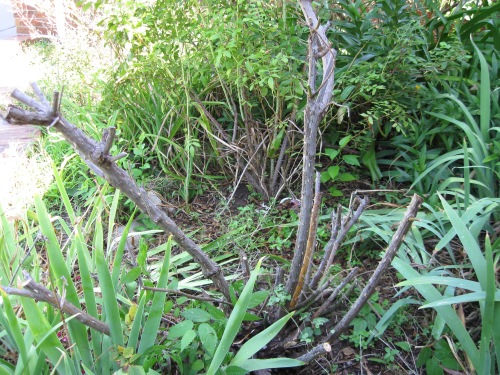For every thing, there is a season ….
We humans were put in charge of this planet, to tend it, nurture it, govern it, and take care of it. And when you nurture something, you have a responsibility toward it. You owe it the respect of accepting and fulfilling that responsibility. Sometimes responsibility dictates that you must kill and remove for the betterment of others. That is why we humans raise and slaughter livestock for consumption and leather goods. It is why we clear fields and plant them, and later harvest them. It is why we pull weeds from our flower and vegetable gardens, removing the plants that we don’t want to make way for those that will flower beautifully or bring us bounty to eat. It is why we chop tree roots that are threatening our house foundation.
Today, I put aside memories, regret, and sentiment and set about bringing down my biggest, first, most special, and oldest Linda Campbell rugosa rose.
In a past post, I chronicled the removal of a different, smaller rose bush of the same variety–the second plant in my current yard to succumb to the horrid rose virus now rampant across our nation. That bush held no sentiment in my heart other than its beauty and ease of care. Yet I fought the virus, fought the inevitability of the plant’s eventual demise. I kept young Linda going longer than I believed possible before I finally gave in to the ugly “witch’s broom” effect and took her out.
 {The deformity isn’t showing well in this photo, but the affected canes are thick and soft, the leaves remain red and strangely shaped, the buds cannot open.}
{The deformity isn’t showing well in this photo, but the affected canes are thick and soft, the leaves remain red and strangely shaped, the buds cannot open.}
Several times this year, I have daydreamed about reconfiguring my large front flower bed. It’s probably the worst landscaping I’ve ever had since I rented my first little house in graduate school and could only afford six marigold plants. At my current address, the largest plants grow in the front. Weed trees sprout in the back. The perennials are in the wrong places. The entire composition fails to please me. And if a front flowerbed is supposed to be the jewel of a home’s entrance, this one would be what’s known as a “dead rhinestone.” It has no sparkle. At its very best, it offers a mishmash of brief spring bloom. All last winter, I thought of making a few changes, of adding a bistro set, of moving the birdbath, of installing stepping stones and mulch, of making it beautiful.
Well, be careful what you wish for.
These days, all but driven from gardening of any kind by dicey joints, tendonitis, and mold allergies, I tend to think and imagine more than I actually accomplish. I have let my responsibilities to my beloved plants slip quite a bit. So I’ve been thinking about changes without making any actual push to bring them about.
Old Linda Campbell is the anchor of this front bed. Since I moved here, she’s been my showstopper, growing huge and wide and tall in the front curve of the raised bed next to the sidewalk and covering herself with enormous red bouquets of bloom all summer long. She was the first Linda Campbell rugosa I ever purchased. I bought her for the front bed of my previous home, and she thrived there in the cheap sand the builder used instead of topsoil, sheltered by the sun-warmed brick in winter and bronzed by the sun in the summer. How she bloomed! How she grew! I cut her back constantly so that visitors could walk past her without being snagged on their way to the front door. She evaded blackspot, required no dead-heading, didn’t care whether I fed her or not. We loved each other wholeheartedly.
 {Here’s old Linda from a different year, blooming away.}
{Here’s old Linda from a different year, blooming away.}
When I moved, I dug her up and plunked her into a large pot. She thrived. She survived the wind-whipped drive to her new location. She survived being dug up again by a so-called landscaper and left lying on the front lawn with her roots exposed until I saved her in the nick of time. For thirteen years she has been MY ROSE. Some of her canes are nearly as large as my wrist. Because of her, I bought several other Linda Campbells, but none of them have ever grown or bloomed as magnificently as she.
But last winter, she began to fail a bit. Last summer she contracted blackspot and staggered against it. This spring she stood a bit ragged, with dead canes in need of removal and her first flush of bloom for the season less than stellar. And then, a few weeks ago, I saw the mutated new growth that told me what was wrong.
The virus had her.

I could have cut away the affected canes. I could have fed her, babied her, tried to save her, but it would be to no avail. There is no cure to this disease except destruction of the affected plant. Keeping her longer would be akin to propping up an elderly dog with cancer and letting it suffer just because I couldn’t bear to part with it.
Linda’s quality of life was doomed. So today I got out the large loppers, trash bags, my elbow-length gloves, and set to work. I bagged everything for the landfill trash since such diseased plants must NEVER go into the municipal compost. By rights, the cuttings should have been burned, but we aren’t allowed to burn in the city limits. And as I cut her down, bit by bit, I mourned her.
Roses have existed for thousands of years. They scented ancient Persian gardens and adorned the hair of Roman maidens. Their oils formed the perfume called Attar of Roses and have been the base of many other fragrances. Their petals were strewn before the chariots of triumphant Roman generals and down the aisles toward bridal altars. Roses symbolize love. The Tudors carved them into architectural motifs, and during the War of the Roses one faction sported the red Tudor rose and the other sported the white Lancaster rose. Roses have grown wild and tough and stalwart in old western homesteads, blooming at the broken steps of little farm houses long since crumbled or abandoned. They have grown from cuttings snipped by elderly women and passed along to granddaughters. They have rambled over fences, climbed archways, sprawled over doorways, and graced the White House gardens.
So why are they dying now? Why have we created horticultural messes with our gene splicing and hybridizations? What mite, what rodent, what gene manipulation is responsible? Is it transmitted via an animal? Is it airborne? I can’t bear to read about the latest discoveries because the disease breaks my heart.
In past years, I found effective stress relief from my day job by walking through my rose garden and dead-heading the spent blooms. These days, I let a lovely, nameless little rose given to me for my birthday swell its spent buds into rosehips, thereby blooming only once for the season, all because I can’t bring myself to walk among my plants with a bottle of rubbing alcohol to sterilize my pruners and avoid spreading disease from one plant to another.
In search of easy care, hybridizers created Knockout roses. No dead-heading needed, but then why walk among them? They need no care. They have no scent. Yes, Knockouts are pretty. They serve their landscaping purpose, gracing the borders of parking lots and filling corners of our yards as blooming shrubs. However, could Shakespeare have penned his immortal line about a scentless modern rose? I grow a few Knockouts, but can a scentless rose beguile the senses the way an old Bourbon or Damask rose can?
Am I to be the generation that sees the extinction of roses? Or will they prevail, the tough ones that aren’t hybrids, that aren’t grafted wimpy things that last for one season and die? We humans are modern. We are busy. We are tech-savvy, yet our super-wheat creates celiac disease and obesity, and our roses and bees are dying.
What does that tell us? Or are we too busy to pay attention? The trend du jour is to eat paleo, yet how many cavemen actually ate cupcakes made from almond flour? (We are kidding ourselves and ignoring too many warning signs of looming agricultural disaster.)
All these gloomy topics floated through my thoughts as I chopped and cut. In gardening, you know some plants will never thrive from the day you plant them. If they don’t solve the problem by dying, then they have to go. You know that some plants reach their natural end and have to go. You know that some plants bloom in peculiar, new, garish colors that surprise you–not in a good way–and they have to go.
As I cut old Linda down, I saw that I had been right to tackle this sad task now and not try to prolong her agony. For the tiny new cane sprouting from her very base was deformed. I have loved her, and I loved her today in putting her down.
All that remains is to dig up her roots. It will be a tough, difficult job–perhaps beyond my strength now–yet I will get it done.
 {A sad ending to a great old lady.}
{A sad ending to a great old lady.}
And will her disease spread to the other roses in the front bed? Who knows? The first plant to succumb in my backyard–a lovely old rose variety called Penelope–was yanked out and a replacement planted a scant foot away from her hole. And after a few years, the newer bush has shown no signs of the disease whatsoever. No other roses in that bed have contracted the virus. So maybe–fingers crossed–old Linda’s companions in the front bed will escape.
Ready or not, happily or not, the front bed is already being reconfigured.
 {Spent blooms from another, lesser Linda Campbell rugosa unaffected as yet.}
{Spent blooms from another, lesser Linda Campbell rugosa unaffected as yet.}


There is no other writer who I’ve read who can convey ideas and emotion better than you. I’m widely read, so I say no other writer at all. Thank you for blessing me today. I’m sorry about your rose friend. All you say is true.
Wow. That’s quite a compliment, dear friend.
I’m so very sorry, and I feel your pain. She was the most magnificent rose. I do think roses will survive, but when I was taking down one of my climbers–I lost them all–I felt just you expressed. I thought there was no hope. However, I still have some roses left, and I’m grateful for the ones that were tough enough to survive. May Linda Campbell rest easy. It was good of you to let her go.~~Dee
Yes, I’ve been thinking of you and how you lost those lovely climbers. I think–I hope–some roses will survive. I wonder if roses that are weakened in other ways are not more susceptible.